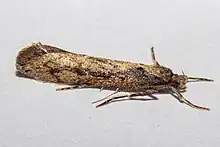| Atomotricha lewisi | |
|---|---|
 | |
| Holotype specimen | |
| Scientific classification | |
| Domain: | Eukaryota |
| Kingdom: | Animalia |
| Phylum: | Arthropoda |
| Class: | Insecta |
| Order: | Lepidoptera |
| Family: | Oecophoridae |
| Genus: | Atomotricha |
| Species: | A. lewisi |
| Binomial name | |
| Atomotricha lewisi Philpott, 1927 | |
Atomotricha lewisi is a moth in the family Oecophoridae.[1] This speceis was first described by Alfred Philpott in 1927 and is endemic to New Zealand. This species has been observed in Central Otago and the Mackenzie Country. The larvae are believed to be soil dwelling with the adults emerging during the winter months of May and June. The female of the species is short winged and flightless and the male of the species have been observed on the wing in August and September.
Taxonomy
This species was first described by Alfred Philpott in 1927 using a specimen likely collected in Central Otago by J. H. Lewis.[2] George Hudson discussed this species in the 1939 in his book A supplement to the Butterflies and Moths of New Zealand.[3] The holotype specimen is held at the New Zealand Arthropod Collection.[4]
Description

Philpott described this species as follows:
♂. 23–24 mm. Head and thorax dull brown mixed with grey. Palpi with terminal segment much shorter than second, ochreouswhitish mixed with brown externally. Antennae annulated alternately with ochreous-whitish and dark fuscous, ciliations in male 5. Abdomen dull brassy-yellow, segmental divisions whitish and some fuscous on basal segments. Legs ochreous-whitish, more or less infuscated. Forewings, costa moderately arched, apex rounded, termen oblique; dull brown; sometimes a broad stripe of ochreouswhite along dorsum, tapering to tornus and triangularly indented above near base, also a suffused stripe of the same colour beneath costa to about ¾; fringes whitish-ochreous with three or four lines of brown points. Hindwings and fringes ochreous-whitish sprinkled with brown.[2]
Philpott studied the male genitalia of this species and stated that that as a result of this study this species is most nearly related to A. isogama.[2]
Distribution
A. lewisi is endemic to New Zealand.[4][5] It has been observed in Central Otago and the Mackenzie Country.[6][7]
Behaviour
The larvae of this species are believed to be soil dwelling.[8] The adults are known to emerge during the winter months of May and June and males have been observed on the wing in August and September.[8][9][10] The females of this species are shortwinged and flightless.[8]
References
- ↑ Gordon, Dennis P., ed. (2010). New Zealand inventory of biodiversity: Kingdom animalia : chaetognatha, ecdysozoa, ichnofossils. Vol. 2. p. 462. ISBN 978-1-877257-93-3. OCLC 973607714. OL 25288394M. Wikidata Q45922947.
- 1 2 3 Alfred Philpott (15 August 1927). "Notes and Descriptions of New Zealand Lepidoptera". Transactions and Proceedings of the New Zealand Institute. 58: 87. ISSN 1176-6158. Wikidata Q107580217.
- ↑ George Vernon Hudson (1939), A supplement to the butterflies and moths of New Zealand, Illustrator: George Hudson, Wellington: Ferguson and Osborn Limited, pp. 451, Plate LIX, OCLC 9742724, Wikidata Q109420935
- 1 2 John Stewart Dugdale (23 September 1988). "Lepidoptera - annotated catalogue, and keys to family-group taxa". Fauna of New Zealand. Department of Scientific and Industrial Research. 14: 90. doi:10.7931/J2/FNZ.14. ISSN 0111-5383. Wikidata Q45083134.
- ↑ "Atomotricha lewisi Philpott, 1927". www.nzor.org.nz. Retrieved 2022-05-01.
- ↑ "Atomotricha lewisi Philpott, 1927". www.gbif.org. Retrieved 2023-11-30.
- ↑ B. H. Patrick (January 1989). "Survey of Lepidoptera at Tara Hills Research Station" (PDF). New Zealand Entomologist. 12 (1): 42–48. doi:10.1080/00779962.1989.9722562. ISSN 0077-9962. Wikidata Q105740636. Archived from the original (PDF) on 9 February 2013.
- 1 2 3 Brian Patrick (1 December 2014). "Winter-emerging moths of New Zealand". The Wētā. 48: 8–14. ISSN 0111-7696. Wikidata Q105343575.
- ↑ Brian H. Patrick (October 1989). "Lepidoptera, Cicadidae, Acrididae of the Manorburn Ecological District" (PDF). Science & Research Internal Reports. 60: 1–6. ISSN 0114-2798. Wikidata Q117581178.
- ↑ "Atomotricha lewisi". iNaturalist. Retrieved 2023-11-30.